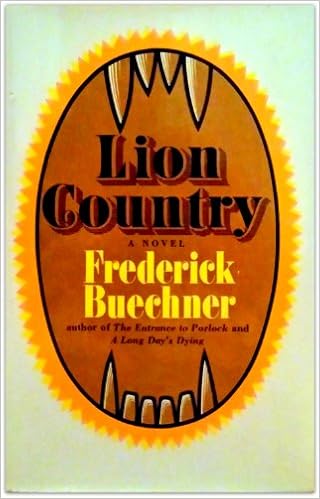Through the summer and fall, I devoured one book after another, focusing on the classics: books whose titles I recognize, books from lists of “Must-Read Classics,” books given to me that seem to have literary value. I finished Frederick Buechner’s Lion Country recently and decided to pause and ponder it before searching for another classic.
I’ve heard Buechner’s name praised by people whose taste I respect. They’ve called him fascinating, insightful, and thought-provoking. Lion Country is the work of a skilled, thoughtful writer: the characters are complex and intriguing (Parr, Sharon, Bebb, Brownie, Lucille, Miriam, and Ellie), the plot is unique (a writer trying to expose an evangelist as a fraud, and being drawn into his world), and the descriptions are concrete, vivid, and create believable settings.
Like Walker Percy’s The Moviegoer and The Last Gentleman, the story asks “How should we live?” and examine life, joy, and longing. It asks great questions and examines important aspects of what it means to be human, and how a flawed person can be an instrument of grace.
I didn’t enjoy it.
Why? Not because it lacked literary value. I could feel Buechner engaging in mystery, layering his story with allusions to mythology and other classics. Yet it didn’t fill my soul as my favorite books do with joy, longing, or peace. It emptied me, filling my mind with sordid images of tangled sheets of the hotel bedroom where Parr has an affair or a subway station that reeks of urine.
My dislike for this book probably reflects my immaturity as a reader. I like “pretty” things and books that celebrate them, books that draw me into worlds that are safe, wholesome, beautiful, and good. Much of the world really is ugly, cruel, and dangerous; the cigarette smoke in subway tunnels, the mud and filth of prison camps, chain-link fences, charred forests, and rivers clogged with chemical waste and plastic. I don’t want to ignore the ugliness of the world. I want to fight it.
Many of my favorite books do acknowledge evil and ugliness: J. R.R. Tolkien writes about the ugliness of Mordor, the Dead Marshes, and Isengard in The Lord of the Rings; Anthony Doerr shows the brutality and filth of World War II in All the Light We Cannot See; Charles Dickens portrays the soot and filth and grayness of Victorian England in his works. But these authors show how goodness and courage can conquer evil, and beauty can arise from ugliness.
So I decided to imitate something Maria did in The Sound of Music, another story in which good and beauty (in this case, love and music) confront evil and horror (the Nazis). I made a list of my favorite things: some concrete, physical objects, some more abstract. I want to fill my stories with these things as signs of goodness against evil. I want to create worlds into which my readers can escape and be comforted, healed, and inspired to transform ugliness into beauty.
I made a list, and then used this great website to turn the list into a word map.
- Hearth fires
- Candlelight
- Magical woods
- Gardens
- Chimneys
- Mountains
- Stone/gold/silver/bronze
- Stars
- Secret valleys
- Rivers
- Springs
- Best friends
- Vines
- Jungles
- Treehouses
- Flying
- Secret coves
- Caves
- Living toys,
- Quests
- Cities on the edge of the world
- Voyages
- Secret passages
- Torches
- Bridges
- Friends
- Magic carpets
- Flowers
- Waterfalls
- Joy, hope, sacrifice, grace, forgiveness, love, compassion, the strong loving the weak,
- Treasure hunting,
- Riddles
- Spells
- Nordic, Egyptian, Celtic, Roman mythology
- Magic and music
- Stone pavement courtyards
- Cathedrals
- Spiral staircases
- Heather
- Labyrinths and mazes
- Magical things that only happen once every century or millenium
- Arctic landscapes
- Underwater tunnels
- Old maps
- Some magical creatures: dragons, phoenixes, unicorns
- Puzzles, mazes like Fablehaven
- Quests
- Gates, country estates
- Ranches
- Rivendell-like havens
- Brothers-sisters
- Boreal forests
- Icebergs
- Fireflies
- Bonfires with s’mores
- Picnics
- Hot chocolate
- Wishing wells
- Castles, palaces, towers, citadels
- Widow’s walks, wraparound porches
- Spanish moss, secretive swamps or bayous
- Glittering caves
- Sea caves
- Tides
- Pearls, diamonds, rubies, sapphires, amber
- Music: piano, cello, flute, choruses
- Lighthouses
- Orchards and vineyards
- Twilight, dusk, gloaming
- Four-poster canopy beds
- Wardrobes
- Fields of flowers
- Thunder-and-lightning storms

To show how light overcomes darkness, and goodness conquers evil, I have to include ugly and dark things in my stories: logging sites, polluted oceans, warehouses, New Jersey industrial meadowlands, battlefields, war zone hospitals, flood zones, gray offices, fluorescent factories. But I would rather be accused of writing “escapist” fiction than create worlds without hope.
What concrete, physical things fill your soul and inspire you to yearn for and cultivate goodness? Make your own list of “favorite things” and how they can populate your stories. If you prefer to think visually, you can also make a Pinterest board of them.
